#summer beauty allium
Photo

Milwaukee Front Yard
Photo of a large modern drought-tolerant and full sun front yard stone garden path in summer.
0 notes
Photo

Traditional Landscape in Milwaukee
Summertime photograph of a sizable, traditional front yard with stone landscaping.
0 notes
Text
Traditional Landscape

Design suggestions for a sizable, traditional front yard with stone landscaping in the summer.
0 notes
Photo
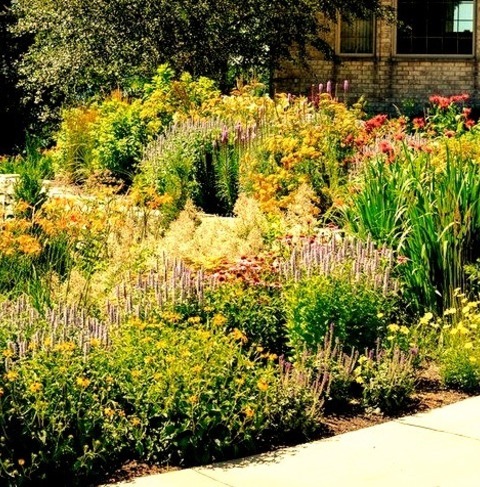
Milwaukee Front Yard
Inspiration for a large traditional full sun and drought-tolerant front yard stone retaining wall landscape in summer.
0 notes
Photo

Traditional Landscape - Driveway
Design suggestions for a sizable, traditional front yard with stone landscaping in the summer.
#bee friendly#perennial gardens#summer beauty allium#coreopsis#landscape design#outcropping#driveway
0 notes
Photo
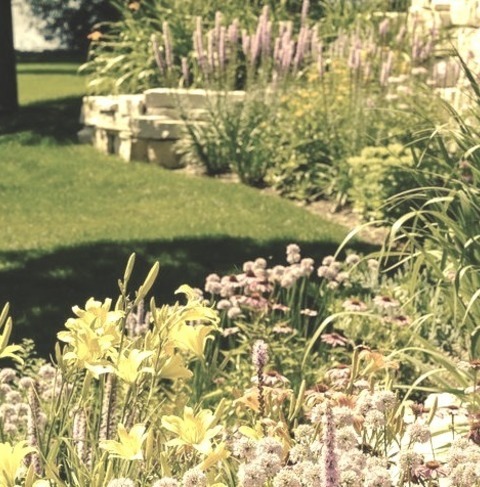
Front Yard Natural Stone Pavers Milwaukee
Photo of a large traditional full sun and drought-tolerant front yard stone retaining wall landscape in summer.
0 notes
Photo
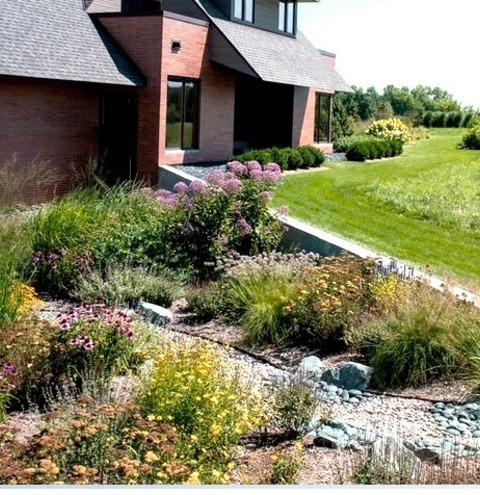
Retaining Walls in Milwaukee
An example of a large contemporary drought-tolerant and full sun front yard gravel retaining wall landscape in summer.
0 notes
Text
Modern Landscape Milwaukee

This is an illustration of a mid-sized, contemporary, mulch-landscaped backyard in the summer sun.
0 notes
Text
Milwaukee Pathway Landscape

Photo of a mid-sized modern drought-tolerant and full sun front yard garden path in summer.
0 notes
Photo
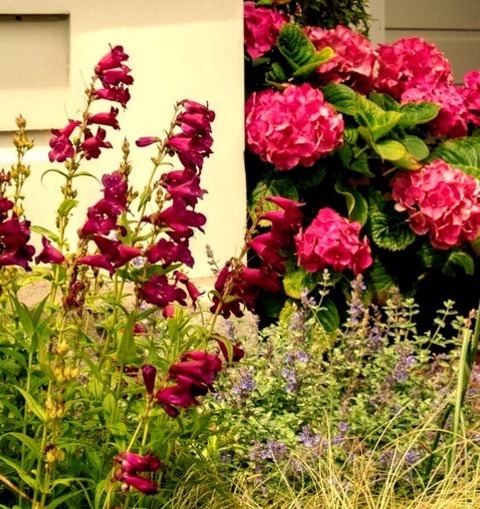
Landscape Flower Bed in Wellington
Inspiration for a small farmhouse full sun front yard flower bed in summer.
1 note
·
View note
Photo

Milwaukee Landscape Pathway
#Inspiration for a sizable traditional stone garden path in the front yard that will receive full sun in the summer. summer beauty allium#front yard#colored concrete#butterfly garden#achillea
0 notes
Text


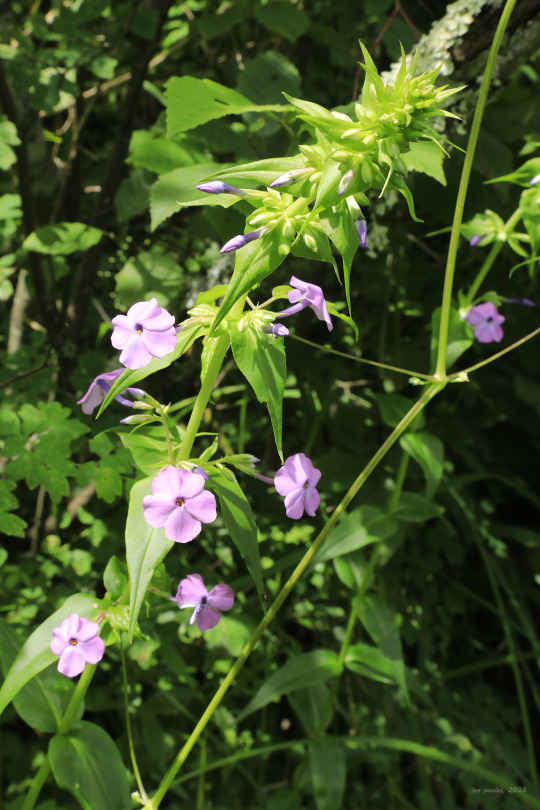

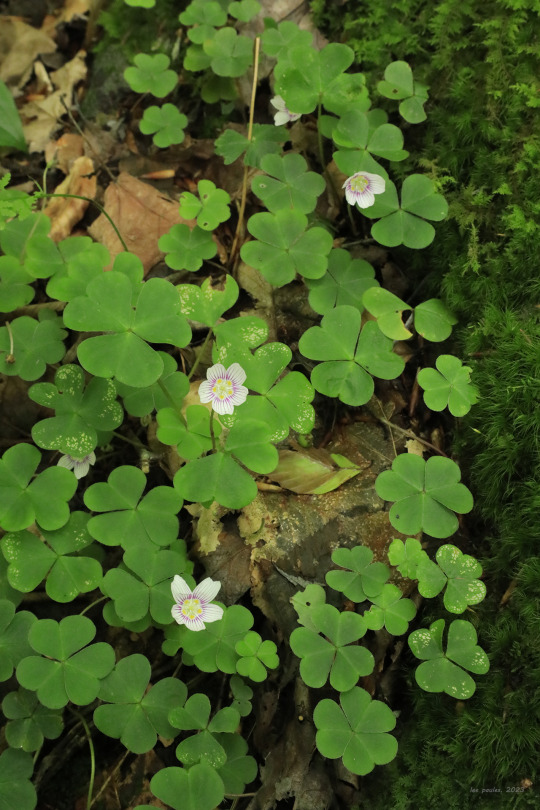

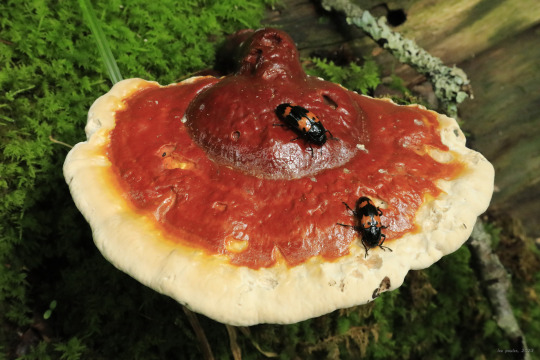


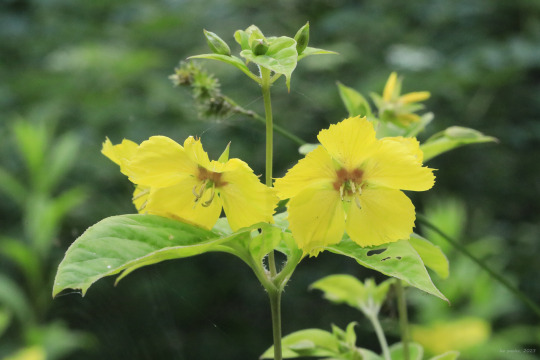
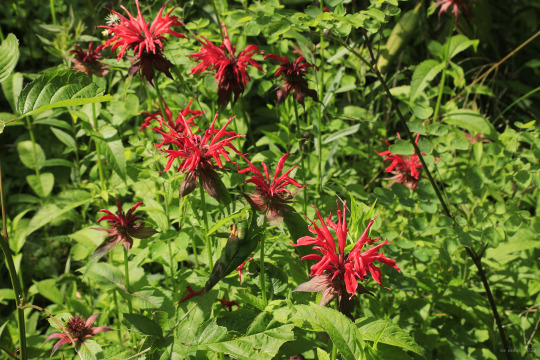
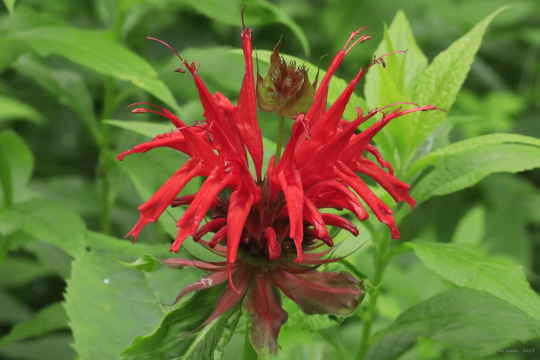
Part 2: Early Summer Wildflower Palooza, Cranberry Glades. During the first week of July, as the orchids are peaking in the bogs and seeps, the first wave of summer wildflowers, including the milkweeds and beebalms, arrives in earnest, bringing a blaze of color to open meadows and bog and forest margins. In the old growth woods of the adjacent Cranberry Wilderness, an array of strange and beautiful fungi sprout from moss-covered logs and the forest floor.
From top: tall meadow rue (Thalictrum pubescens), also known as king of the meadow, a wetlands-loving perennial whose distinctive, cream-colored flowers are composed of thread-like stamens only; meadow phlox (Phlox maculata), also known as wild sweet William and spotted phlox, easily distinguished from other phlox species by its red-spotted stems; mountain wood sorrel (Oxalis montana); a ramp (Allium tricoccum) flower, which emerges in early summer on a leafless stalk, after the foliage has died back; a shiny hemlock varnish shelf (Ganoderma tsugae) assailed by pleasing fungus beetles (Megalodacne), rarely seen because they hide under leaf litter during the day and feed on Ganoderma fungi at night; a lovely colony of crown-tipped corals (Artomyces pyxidatus); the beguiling fringed loosestrife (Lysimachia ciliata), an aggressively-colonizing perennial that makes for a shady ground cover in native wildflower gardens; and that blazingly-beautiful mint, scarlet beebalm (Monarda didyma), whose storied history as a medicinal herb stems from its antiseptic and stimulant properties.
#appalachia#vandalia#west virginia#wildflowers#allegheny mountains#flora#early summer#cranberry glades#monongahela national forest#fungi#insects#beetle#pleasing fungus beetle#tall meadow rue#king of the meadow#meadow phlox#wild sweet william#spotted phlox#mountain wood sorrel#ramp#wild leek#hemlock varnish shelf#crown-tipped coral#fringed loosestrife#scarlet beebalm#oswego tea
87 notes
·
View notes
Text
Tag Game
Thanks for the tag @quillofspirit
Favorite time of the day: I have to say sunrise, early sunrise to be specific, I'm a night person but when I'm doing my morning walk for my mental health it has to be my favorite part of my day.
Favorite aesthetic: hmm... I have to say Skater Boy or 1700s. Weird core has a special spot in my heart also cause that was my edgy teen phase in middle/high school
Color that describes me: I want to say purple because its my favorite color but to quote my roommate who i asked about this, "yellow, cause your happy, autistic, and annoying but in a good way"
Favorite quote: "If someone throws a glass of wine at you, don't throw one back. throw the decanter. That is exactually what I plan to do with this ship" (i think that's the right wording) -john fisher, first baron fisher, talking about the hms dreadnoughts guns.
Current Obsession: dreadnoughts, potc, the navy, fish, all that fun stuff!!
Favorite texture: the feeling of the wool i use for needle felting!
Favorite outfit: so let me explain, i have this crop top polo frog shirt that a friend bought me as a half joke and these rubber duck swim shorts that i found one time and paired together they are a beautiful outfit perfect for summer
Place in the world or universe I’d Live: I have to agree with @quillofspirit about Scotland, i also would love to live in Greenwich England, somewhere in Germany, or ohma in northern Ireland cause thats where my grandfather was from!
Favorite flower: ooh, i have to say alliums, there just so pretty!!
Tagging whoever!!
2 notes
·
View notes
Text
A List of Herbs for the Magickal Practitioner
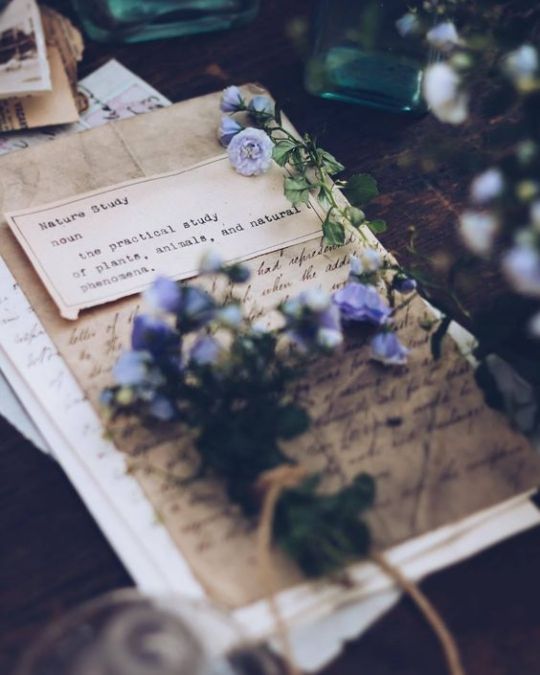
Within the herbs, the magick resides, waiting to be unleashed.
Three of my favorites
Sage...this is the old stand by. Everyone uses sage for smudging and cleansing space, from American Native Shamans to Eastern European Witches. It is the most basic herb in our magickal cupboard. It holds a sacred spot in the small herb garden by my back porch, where it grows into a luxurious green mound every year. My grandmother made tremendous mundane use of sage at Thanksgiving and Yule, adding copious amounts of this herb to her homemade dressing-- I must be thoroughly cleansed, both inside and out.
Rosemary...this is another herb noted for its cleansing properties. But I never think of it cleansing the same way as Sage. I think of it more as a matronly celtic woman in a handmade woolen shawl scrubbing away at whatever is put before her. The aroma of rosemary makes me think of pine trees, and I would never use it for it's mundane use of flavoring certain meats; I'd just as soon sprinkle pine needles over my stew! Make an infusion of rosemary and keep it chilled in the fridge, put some on a cotton ball to tone your face, rejuvenate your skin, and magickally add the illusion of youth. On a very different note and level-- a rosemary wash will chase the fleas off your cat.
Lavender...This is a pot of lavender growing in my own garden. Remember the voice of Aunt Franny in the movie "Practical Magic"?-- "Grow lavender in your garden for luck." And I do. But I also use it in oils made to enhance psychic awareness, love sachets, dream pillows, etc. It's also one of my favorite scents to add directly to my skin, bathwater, and shampoos. It has a soft and gentle essence about it, lavender does, yep.
Flower Power
I was just talking to my girls the other day about flowers and foliage and the seasons. I mentioned that it seems, after that first brilliant ‘coming to life’ in the spring, there is a hot and lazy period. Everything seems scorched and beaten by the summer sun, wilted and tortured by the elements of the dog days of summer; and then comes autumn, blessed autumn. It’s like a second birth, a brilliant blossoming, a breath of cool fresh air that seems to revitalize the world of flora. Everything in the garden throws itself into color and beauty with renewed energy, just in time to begin turning for a glorious autumn show.
Many of the flowers that highlight this time of year are also some of my favorites, and it’s these flowers and plants that I’m going to look at from a magickal point of view. What are their connections to the elements? the planets? magickal intentions? How can I use them to work my magick in order to promote positive change?
Acacia: It’s gender is masculine (projective), it’s planet is the Sun, and it’s element Air. Acacia is used for protection and to promote psychic powers. Burn a small amount of the wood with sandalwood before practicing divination. A sprig from this tree kept in the home will ward off evil and protect the inhabitants from negative outside influences.
Allium: It’s gender is feminine (receptive), it’s planet Venus, and it’s element Water. I use allium in spells for feminine empowerment, to heighten intuition and psychism, and to promote feelings of love and well-being. I’ve used it both in mojo bags and magickal oils.
Alstromeria: White/pink/peach– the gender is feminine (receptive), the planet Venus, the element Earth; yellow/orange/red– the gender is still feminine (receptive), but it carries a bit of a punch; the planet is Mars, the element Fire. I use the milder more gentle form to work gentle magicks, the more robust colors I use in protection magick and self-empowerment spells, when you need strength and good dose of moxie.
Amaranthus: The gender is feminine (receptive), the planet Saturn, and the element Fire. The deity for amaranthus is Artemis– the feminine warrior/huntress. The magickal powers contained within this plant includes healing, protection, and invisibility. Amaranthus was used in pagan burial rites.
Anemone: It’s gender is masculine (projective); the element is Fire, and the planet is Mars. Deities associated with anemone are Adonis and Venus. This plant is also used for health, protection, and healing. To prevent disease, carry the blossoms from this plant in a red cloth upon your person. This plant can also be used in spells dealing with health issues involving blood and the reproduction organs. To keep an enemy at bay, place their photo in a red bag with a handful of the blossoms, or the root of the plant– and leave the dirt in place.
Baby’s Breath: The gender is masculine (projective), the planet Mercury, the element Air. I use Baby’s Breath for magick encompassing communication and creativity. I’ve also used this plant in love spells to instill good open lines of communications between couples, or to loosen the tongue of a shy partner– just be careful how much and how often you do this, you might be surprised at what’s released– or unleashed.
Bittersweet: The gender is masculine (projective), the element is Air, and the planet– Mercury. The most popular magickal use for bittersweet is in spells for protection and healing. I’ve also discovered that this plant, connected to the energies of Mercury and Air, is wonderful for issues of communication, clear thinking, powers of deduction, and the spark of creativity.
Carnation: The energy is masculine (projective), the planet is the Sun, and the element is Fire. Use the magick of the carnation for protection, strength, and healing. Use carnations in healing spells. Place carnations in a sick room to give strength to the one who is ill. Use this flower in healing rituals, mojo bags, and oils.
China Berry: This plant is used for luck. The seeds are considered good luck charms, so use them as thus, particularly in bags or lockets, where you can carry them upon your person. The China Berry can be used in spells to precipitate change.
Chrysanthemum: It’s gender is masculine (projective), the element is Fire, and the planet– the Sun. Chrysanthemums are used primarily for protection. Grown in the garden, they are reputed to keep evil spirits away– and in this case, my garden should be totally free of evil spirits, because I’ve accumulated a mass of mums this autumn. I take this one step farther by color associations– yellow blossoms for spells meant to help you find your voice; magenta blossoms for a good strong dose of pure love, and white blossoms to throw an honest light on any situation.
Cockscomb: The energy is masculine (projective), the element Fire, the planets Jupiter and Mars. The no nonsense energy of the Cockscomb can be used to discover and unleash the masculine side of yourself, when aggression, strength, and courage are called for. The most beautiful cockscomb flowers I’ve seen was in Iowa, when we were traveling through Amish country.
Cosmos: The energy is feminine (receptive), the planet is Earth, and the element is Earth. I use the lovely petals from this plant for goddess magick; to highlight feminine energy– for maiden, mother, and crone; for healing spells dealing with female issues; for safe childbirth; to celebrate those rituals geared toward women and their life milestones, including female puberty rites and a croning
Echinops: The energy of the thistle will be found within this plant. It’s gender is masculine (projective), the planet is Saturn, and the element is Fire. Use the Echinops in spells for protection and self defense. This plant will also be used in hexing and cursing spells, added to poppets or mojo bags.
Freesia: The planet– the Moon, the element is Water, the gender is feminine (receptive). The Freesia contains the constantly mutating and fluid energy of the Moon and the element of Water. Use this plant according to color correspondences for a surprisingly wide array of magickal intentions. White, for those things of spirit and spiritual energy; red for passion, including not only physical passion, but passion for many things of life; pink to inspire friendhip and loyalty; yellow for God energy, and healing.
Gerber Daisy: The gender is masculine (projective), the planet Saturn, the element Fire. The daisy and the gerber daisy both possess strong energies for love spells, the gerber daisy being more ‘hot-blooded’, meaning there will be more animalistic passion in love spells done with the gerber daisy. This plant can also be used in spells when the energy just needs to be riled up a bit, when you need to light a fire and get people and circumstances moving.
Hypericum: The gender is masculine (projective), the element Air, the planets Mercury and the Sun. The beautiful yellow flowers of this plant can be used in mojo bags and spells to enhance communication, for god energy, for healing, and for spells of self-empowerment.
Juniper: It’s gender is masculine (projective), the element is Fire, the planet is the Sun. The magickal powers of Juniper include protection, protection against theft, love, exorcism, and health. I also use Juniper berries for spells geared to the Winter Solstice, youth & immortality, and spiritual rejuvenation. Juniper is reputed to promote male potency when used in love spells– though I have not personally put this theory to the test.
Kangaroo Paw: It’s gender can be both masculine (projective), or feminine (receptive), depending upon what type of magick you’re using it for, and which planet you’re using for the correspondence. The planets are Mercury and Venus, the elements Air and Water. I have primarily used Kangaroo Paw for fairy magick.
Kalancheo: The gender is feminine (receptive), the planet Venus, the element Earth. Magickally speaking, use the pink blossoms for friendship and healing, the red blossoms for love, and the white blossoms for healing.
Liatrus: The gender is feminine (receptive), the planets Venus and Jupiter, the element Water. This plant is best used for all of its connections to the element of Water, which includes the promotion and growth of your psychic abilities, intuition, dreams and visions.
Gloriosa: The energy of this plant is most decidedly feminine (receptive), its elements both Water and Earth, and the planets Venus and Earth. The Gloriosa blossom is representative of the female anatomy, and its magickal energies are best used for female health issues, fertility, female sexual issues, and female self-empowerment. This plant can also be used in spells, magicks, and spiritual practices to glorify and worship the Mother Goddess.
Misty Blue: The gender is feminine, the planet is Water, the element Water. Use this plant for spiritual practices, for spirit contact, and to promote contact in general with the unseen world and the entities which inhabit it.
Orchid: This is a very versatile plant, magickally speaking. It’s energy is masculine (projective), the element Air, the planet Mercury. Use the orchid in your spiritual practices and spell crafting according to the color of its blossoms: red/love and passion, pink/friendship and well-being, white/spirituality and healing. Personally, I use the speckled blossoms when change is needed and desired.
Pepper Berry: The gender is masculine (projective), the element is Air, the planet is the Sun. The red berries and green foliage from this plant make beautiful additions to wreaths. Magickally, I use Pepper Berry in mojo bags and magicks that deal with the Winter Solstice, God energy, and especially new beginnings.
Protea: It’s gender is masculine (projective), the element Air, the planet Jupiter. The primary magickal use for protea is for spells and magicks that move a situation along so that a final conclusion or decision can be reached. The various methods will include mojo bags and candle magick. This type of magick works best when worked over a period of three to seven days.
Queen Ann’s Lace: It’s gender is feminine (receptive), the planet is Venus and Jupiter, the element Earth. I primarily use Queen Ann’s Lace for issues of fertility, and this can mean not only fertility in the physcial world, but fertility of ideas and creative energies, creativity concerning unusual opportunities, etc. This plant is also used in magicks for Goddess energy and self-empowerment.
Roses: The gender is feminine (receptive), the planets are Venus and the Moon, the element is Water. Roses are most strongly connected with love spells. Use the energies of the various colors for different types of love– red/passionate affairs with lusty sex, or soul mate connections; pink/for strong bonds of loyalty, friendship, and fidelity; yellow/for peaceful partings, to say good-by; white/to honor a love who has passed, or to honor a relationship that has come to a natural conclusion. The white blossoms of a rose can also be used in spells and magick to contact a deceased partner.
Rowen Berry: It’s gender is masculine (projective), its planet Mars, and the element is Fire. Use the warrior energy of Mars and the fiery passion of Fire with the rowan berry in spells and magickal workings that require strength, concentrated doses of high energy, courage, passion of intention, and a strong will power. The poisonous berries are also potent when used in spells and magicks for hexing and cursing. Added to mojo bags and poppets, they work with a vengence.
Salvia: The gender is masculine (projective), the element is Water, and the planets are the Sun and the Moon. Salvia is part of a large family of plants which includes Sage. The primary use for salvia is for cleansing and smudging. Use the smoke from saliva to smudge your home and personal space, your person, your vehicle, or your land. Tie up dried bunches and hang them in the four corners of your home for protection, or hang a bundle of salvia by the front door to prevent anyone wishing you harm from entering.
Solidago: The gender is feminine (receptive), the planet is Venus, the element Air. Solidago, more commonly known as Golden Rod, is used for magickal workings involving money and divination. Carry a sprig of goldenrod in your wallet or purse to insure enough money to cover your needs. Place a piece of pyrite with it. Put a sprig of this plant in a small wooden box large enough to hold your tarot cards or set of runes to enhance the magick of divination and your intuitive powers.
Statice: This plant’s gender is masculine (projective), its element Air, it’s planet Mercury. I personally use statice in magick which highlights or incorporates group events, the gathering of people, peaceful conclusions to group debates or disagreements, as well as to promote peaceful cohabitation and successful growth within an organized group.
Star of Bethlehem: The gender is masculine (projective), the planet is the Moon, the element Water. I use the six pointed white blossoms of the Star of Bethlehem in spells and magicks involving spirituality, personal empowerment, and cleansing. I’ve also found it wonderful for Goddess invocation and feminine magicks. It is energy is inspiring and purifying.
Sunflower: The gender is masculine (projective), the planet is the Sun, the element Fire. The magickal powers of the sunflower includes fertility, wishes, health, and wisdom. Use the seeds from this plant in fertility spells, the yellow blossoms in magicks geared to gain your wish, and to inspire wisdom when wisdom is desired and needed. Carry a mojo bag containing various aspects of this plant for good health.
Yarrow: Yarrow’s gender is feminine (receptive), it’s planet is Venus, and the element Water. The magickal powers of yarrow includes areas of courage, love, psychic powers, and exorcism. Place a bouquet of yarrow on your table during divination sessions, in the four corners of your house to keep evil entities at bay, or place a sprig of yarrow in the pocket of the person you love. I’ve used yarrow in dream bags that I’ve placed beneath my pillow to inspire prophetic dreams and visions. You might want to add a marigold blossom to this bag and a stone of amethyst.
Zinnia: The gender is masculine (projective), the planets Mercury and Jupiter, the element Air. Use zinnias in spells and magicks where courage, fortitude, and strength are needed. This is also a good plant to use in healing spells, and spells of protection. As the zinnia stands strong and tall, so shall it inspire these attributes when you tap into it’s magick.
15 notes
·
View notes
Text
Flower Correspondence
Minecraft has an array of flowers that can be used as ingredients for spells!
Originally the game started out with only two flowers which are the dandelion and the poppy (which was originally called a rose at the time).
Now, as of 1.19, it's grown to 17 different flowers and all that can be located in an array of different biomes.
This list will detail the dye that can be crafted from them, and the meaning of the flowers themselves so you can figure out which can suit the sort of spell you want to use them in.
Note: I am also in the belief that the flowers can also be used to stand in for the correspondence for the dye colours as well, but if you want to see the meanings of dye colours then that's over at [Dyes and Colour Palettes]

Dandelion
dye: yellow
resilience, the sun, manifesting desires, happiness, triumph over adversity
Poppy
dye: red
remembrance, death, sacrifice, peace, sleep, undying love
Blue Orchid
dye: light blue
beauty, fertility, love, unity, honesty, protection, strength, luxury, rarity
Allium
dye: magenta
unity, good fortune, prosperity, patience, eternal life, protection, health, exorcism, divination, wisdom, spirituality
Azure Bluets
dye: light grey
contentment, peace, innocence, freedom, hope
Red Tulip
dye: red
eternal love, wealth, abundance, prosperity, passion, romantic love
Orange Tulip
dye: orange
enthusiasm, joy, love, compassion, excitement, understanding, appreciation of connections
White Tulip
dye: light grey
forgiveness, compromise, purity, peace
Pink Tulip
dye: pink
health, self-confidence, love, happiness, positivity, affection
Oxeye Daisy
dye: light grey
children, new beginnings, happiness, innocence, love, divination, the sun, light, health
Cornflower
dye: blue
hope, prosperity, love, patience, fertility, divination, devotion, angels, healing, freedom, resilience, strength, loyalty, responsibility, courage
Lily of the Valley
dye: white
hidden danger, purity, rebirth, protection against evil, return of happiness, sweetness, honesty sadness, motherhood
Wither Rose
dye: black
death, transformation, resilience, strength, sacrifice
Sunflower
dye: yellow (x2)
spirituality, the sun, happiness, loyalty, joy, long life, health, good luck, absorbing negativity, abundance, friendship, summer
Lilac
dye: magenta (x2)
wisdom, spring, new beginnings, renewal, love, romance, spirituality, memory, protection from evil, dispelling negative energies
Rose Bush
dye: red (x2)
passion, love, appreciation, secrets, wisdom, health, soothing, beauty
Peony
dye: pink (x2)
prosperity, good fortune, beauty, luck, gentle transitions, patience, bravery, joy, sweetness, love, compassion, kindness
23 notes
·
View notes
Text
a long, slow harvest
It's harvest season, and many of us look forward to this turn in the year to gather the fruits of our labors. For my farmer and gardener friends, they hold heavy, tangible achievements, from wee little carnival squash to the behemoth monsters I’ve helped drag out of their fields in past years. For others, maybe it means a different kind of harvest - the kind that comes from months of hard work finally leading to our less tangible efforts bearing something we can hold in our hands.
But this year feels different, doesn't it? The world feels a quieter, a little less certain. While many of my social circles continue to spin ever outward, seemingly blithe about the alarming rise in illness that seems prevalent in almost every place I know a loved one, more vulnerable people like me are having to adjust to a new normal to compensate for the imbalance, one that includes a lot more isolation than we might like. (We see this in ecosystems, too, when one species perhaps stretches itself out a little too much for others to thrive alongside it; but that’s an entry for another time.) Even so, there is still beauty to be found. There is still comfort to be had in the simple things.
Like squash, one of my favorite homely bounties with an equally homely name. This time of year, squash is everywhere – pumpkins, acorn squash, spaghetti squash. There’s a local grocery store where I live that has over 40 kinds of squash, and I delight in comparing their rhinoceros-thick hides and lumpy miens whenever it’s time to put in my weekly order. Squash is cheap, easy to find, versatile, a perfect comfort food for a chilly autumn evening and cozy consolation for many, many nights spent in with my pet rats, my gigantic allium-named cat, and my own welcome, solitary company.
Maybe it's the shorter days and longer nights. Maybe it's the way the leaves are changing color. Or maybe it's just because everything feels both a little more cozy and a little more melancholy when there's a chill in the air. Whatever the reason, I find myself wanting to slow down and savor this time of year. To take stock of all that I've accomplished over the past few months, and to reflect on all that lies ahead in the months to come. Even though this harvest season may look a little different than usual, I'm going to try to embrace it for all that it is - long, slow, and full of possibility.
As a kid, my two favorite kinds of squash year-round were hobak jeon, pan-fried coins of summer squash lightly dredged in a simple egg batter, and hobak juk, a bright orange rice and winter squash porridge that was sweet as dessert and ten times more satisfying. I loved the way it warmed me up from my core to my fingers, even when it was hot out. During my long summers with family in Korea, I often mystified my grandmother by asking her to make us hobak juk, and even though she sometimes grumbled about how we’d season it by sweating right into our bowls, she always did. I’ve been thinking about her a lot this season. I think one of these long, slow evenings, I’ll try to make a bowl, for the memory of both of us. Her, in her light summer clothes, ladling the bright orange bowls out to me and my sister; and me, many years younger, thinking that the harvest could never end, and my loved ones would never leave.
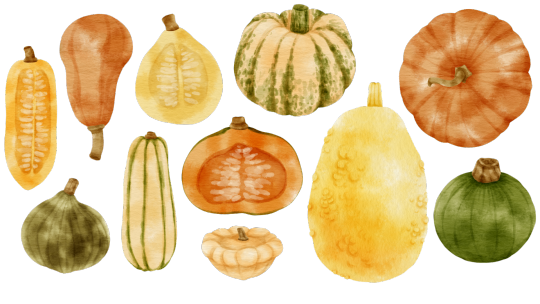
This personal essay also appears on my blog.
For more writing, community, and squash and soup season enthusiasts, consider either signing up for my newsletter or joining the Dirtgoblin Community Center!
16 notes
·
View notes